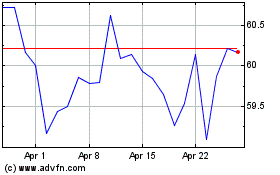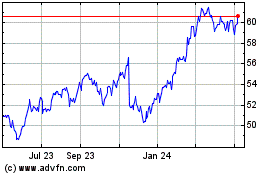Walmart Extends Streak of Sales Growth -- Update
May 16 2019 - 8:50AM
Dow Jones News
By Sarah Nassauer
Walmart Inc. said its sales rose during the first quarter,
adding to over four years of sales increases as the retail behemoth
grabs market share from struggling competitors and grows
online.
Sales at U.S. stores and websites operating at least 12 months
grew 3.4% during the quarter ended April 26, boosted by online
sales, including grocery, and a strong Easter buying season, the
company said Thursday.
In the U.S., sales grew steadily throughout the quarter, the
company said, even as retail sales data released earlier in the
week showed a slight slowdown in spending in April. Meanwhile,
Macy's this week reported slightly better-than-expected comparable
sales in the latest quarter, up 0.6%.
Walmart stocked more goods during the quarter than the same
period last year. Inventories were up about 5.9% as the retailer
accelerated buying in some categories and bulked up product
quantities in its e-commerce fulfillment centers as it works to
deliver online orders more quickly.
Walmart faces higher potential product prices after the Trump
administration last week increased tariffs on about $200 billion of
goods imported from China to 25% from 10% and threatened a further
set of tariffs on all Chinese imports.
The company's shares rose 2.2% in premarket trading
Thursday.
"We feel good about the quality of the inventory position and
expect quantities to normalize as the year progresses," said Brett
Biggs, Walmart's chief financial officer, in a news release.
Walmart is the largest importer in the country, according to the
Journal of Commerce. But around 56% of its U.S. sales are from
groceries, which are less likely to come from China than other
products such as Christmas lights or apparel. Around two-thirds of
Walmart's purchases are made in the U.S., company executives have
told investors.
"We're monitoring the tariff discussions and are hopeful that an
agreement can be reached," said Mr. Biggs. Walmart's merchant teams
have been focused on mitigating price increases for months, he
said. "Our goal is to always be the low-price leader, and we will
actively manage pricing and margins."
While some retailers have closed or seen sales sputter in recent
years with the rise of online shopping, quarterly comparable sales
have risen consistently in Walmart's primary U.S. business for over
four years.
Walmart has shifted strategies, significantly reducing spending
on building new stores in favor of growing online, lowering prices
and adding more services in physical stores like online grocery
pickup. Last week Walmart said it has invested in its online
delivery network over the past two years to speed delivery
times.
Profits have come under pressure as more revenue comes from
lower-margin online sales and online investments continue.
Walmart's operating income in the quarter fell 4.1% to $4.9
billion, in part because its purchase of Indian e-commerce startup
Flipkart last year is weighing on profits as expected.
In the U.S., the largest piece of Walmart's business, operating
income grew 5.5%, as some transportation costs subsided and online
sales margins improved, countered by continued efforts to lower
prices.
E-commerce sales continued to rise, boosted by a rapid expansion
on online grocery offerings, up 37% in the U.S. during the quarter.
Walmart has said it expects U.S. e-commerce sales to grow 35% for
the full fiscal year.
Total company revenue rose 1% to $123.9 billion from $122.7
billion during the same period last year.
Write to Sarah Nassauer at sarah.nassauer@wsj.com
(END) Dow Jones Newswires
May 16, 2019 08:35 ET (12:35 GMT)
Copyright (c) 2019 Dow Jones & Company, Inc.
Walmart (NYSE:WMT)
Historical Stock Chart
From Mar 2024 to Apr 2024

Walmart (NYSE:WMT)
Historical Stock Chart
From Apr 2023 to Apr 2024
